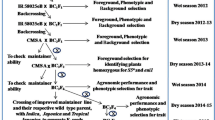Abstract
Oryza rufipogon (IRGC105491) is a wild relative of cultivated rice, it contains two favorable yield-enhancing genes (yld1.1 and yld2.1) on chromosomes 1 and 2, respectively, which are capable of improving the yield of hybrid rice by 18 and 17%, respectively. SSR markers RM9, RM24, RM5 and RM306 are flanking yld1.1, while RM166 and RM208 are mapped in the close region to yld2.1. These molecular markers tightly linked to the two yield-enhancing genes were used to screen the plants of backcross population between ‘9311’ (one of the top-performing parental lines in super hybrid rice seed production in China) and O. rufipogon. The results were as follows: (1) in BC2F1 population, the percentage of the individuals which contain both of the O. rufipogon alleles at marker loci RM166 and RM9 was 16.8%; (2) 1.5% individuals of total BC3F1 population have all the six linked markers (RM166, RM9, RM5, RM208, RM24, RM306); (3) in BC4F1 population, the percentage of the individuals which contain both of the two O. rufipogon alleles at marker loci RM166 and RM9 was 18.0%. Based on marker genotypes, the individuals, that contain multiple O. rufipogon markers, were selected and used for further backcross and self cross. Many ‘9311’-type lines with yield-enhancing genes and high yield potential were obtained. After three times self-crossing a stable improved ‘9311’ line was obtained. The results indicated that these molecular markers are feasible for marker-assisted selection (MAS) to screen rice individuals with high yield potential.
Similar content being viewed by others
References
Hospital, F. & A. Charcosset, 1997. Marker-assisted introgression of quantitative trait loci. Genetics 147: 1469–1485.
Huang, N., E.R. Angeles, J. Domingo, G. Magpantay, S. Singh, G. Zhang, N. Kumaravadivel, J. Bennett & G.S. Khush, 1997. Pyramiding of bacterial blight resistance genes in rice: Marker-aided selection using RFLP and PCR. Theor Appl Genet 95: 313–320.
Knapp, S.J., 1998. Marker-assisted selection as a strategy for increasing the probability of selecting superior genotypes. Crop Sci 38: 1164–1174.
Kwon, Y.S., M.Y. Eun & J.K. Sohn, 2001. Marker-assisted selection for identification of plant regeneration ability of seed-derived calli in rice (Oryza sativa L.). Mol Cells 1: 103–106.
McCouch, S.R., X. Chen, O. Pannaudo, S. Temnykh, Y. Xu, Y.G. Cho, N. Huang, T. Ishii & M. Blair, 1997. Microsatellita marker development, mapping and application in rice genetics and breeding. Plant Mol Biol 1/2: 89–99.
Moreau, L., A. Charcosset, F. Hospital & A. Gallais, 1998. Marker-assisted selection efficiency in populations of finite size. Genetics 148: 1353–1365.
Spelman, R. & H. Bovenhuis, 1998. Genetic response from marker assisted selection in an outbred population for differing marker bracket sizes and with two identified quantitative trait loci. Genetics 148: 1389–1396.
Tanksley, S.D. & J.C. Nelson, 1996. Advanced backcross QTL analysis: A method for the simultaneous discovery and transfer of valuable QTLs from unadapated germplasm into elite breeding lines. Theor Appl Genet 92: 191–203.
Temnykh, S., G. DeClerck, A. Lukashova, L. Lipovich, S. Cartinhour & S. McCouch, 2001. Computational and experimental analysis of microsatellites in rice (Oryza sativa L.): Frequency, length variation, transposon associations, and genetic marker potential. Genome Res 11: 1441–1452.
Visscher, P.M., C.S. Haley & R. Thompson, 1996. Marker-assisted introgression in backcross breeding programs. Genetics 144: 1923–1932.
Xiao, J.H., S. Grandillo, S.N. Ahn, S.R. McCouch, S.D. Tanksley, J.M. Li & L.P. Yuan, 1996. Genes from wild rice improve yield. Nature 384: 223–224.
Xiao, J.H., J.M. Li, S. Grandillo, S.N. Ahn, L.P. Yuan, S.D. Tanksley & S.R. McCouch, 1998. Identification of trait-improving quantitative trait loci alleles from a wild rice relative, Oryza rufipogon. Genetics 150: 899–909.
Xu, S.B., Y.F. Tao, Z.Q. Yang & J.Y. Chu, 2002. A simple and rapid methods used for silver staining and gel preservation. Hereditas (Beijing) 3: 335–336.
Yuan, L.P., 1997. Hybrid rice breeding for super-high yield. Hybrid Rice 6: 1–3.
Zhai, W.X., X.B. Li, W.Z. Tian, Y.L. Zhou, X.B. Pian, S.Y. Cao, X.F. Zhao, B. Zhao, Q. Zhang & L.H. Zhu, 2000. Introduction of a rice blight resistance gene, Xa21, into five Chinese rice varieties through an Agrobacterium-mediated system. Science China (Series C) 4: 361–368.
Zheng, K., N. Huang, J. Bennett & G.S. Khush, 1995. PCR-based marker-assisted selection in rice breeding. IRRI Discussion Paper No.12, IRRI, Philippines.
Author information
Authors and Affiliations
Corresponding author
Rights and permissions
About this article
Cite this article
Liang, F., Deng, Q., Wang, Y. et al. Molecular marker-assisted selection for yield-enhancing genes in the progeny of “9311×O. rufipogon” using SSR. Euphytica 139, 159–165 (2004). https://doi.org/10.1007/s10681-004-2560-1
Received:
Accepted:
Issue Date:
DOI: https://doi.org/10.1007/s10681-004-2560-1




